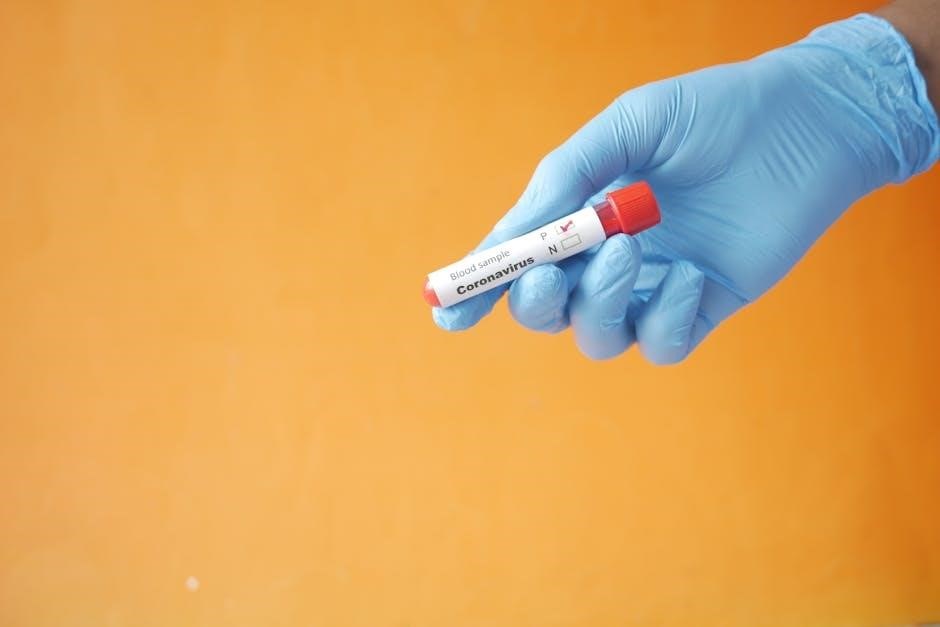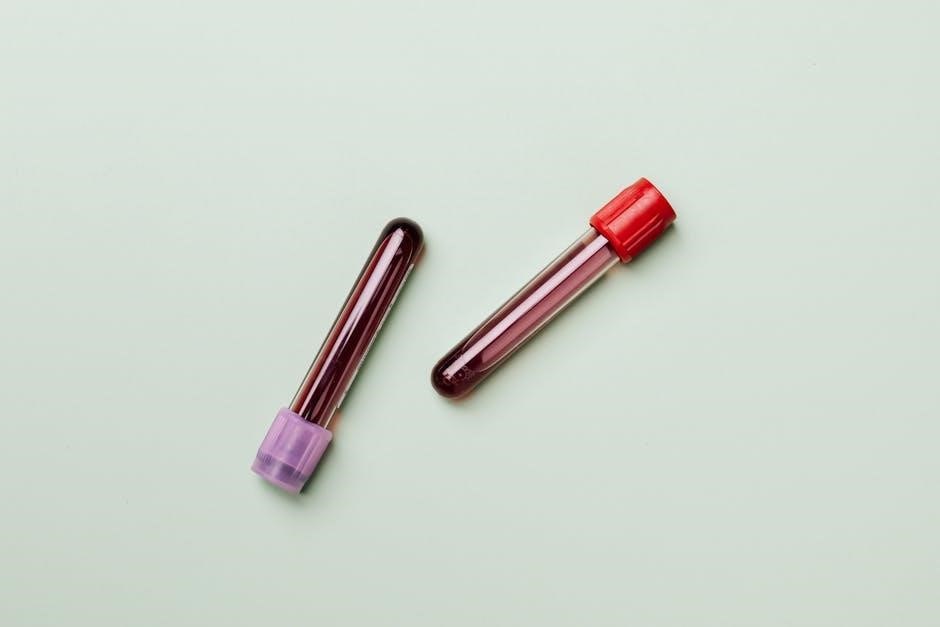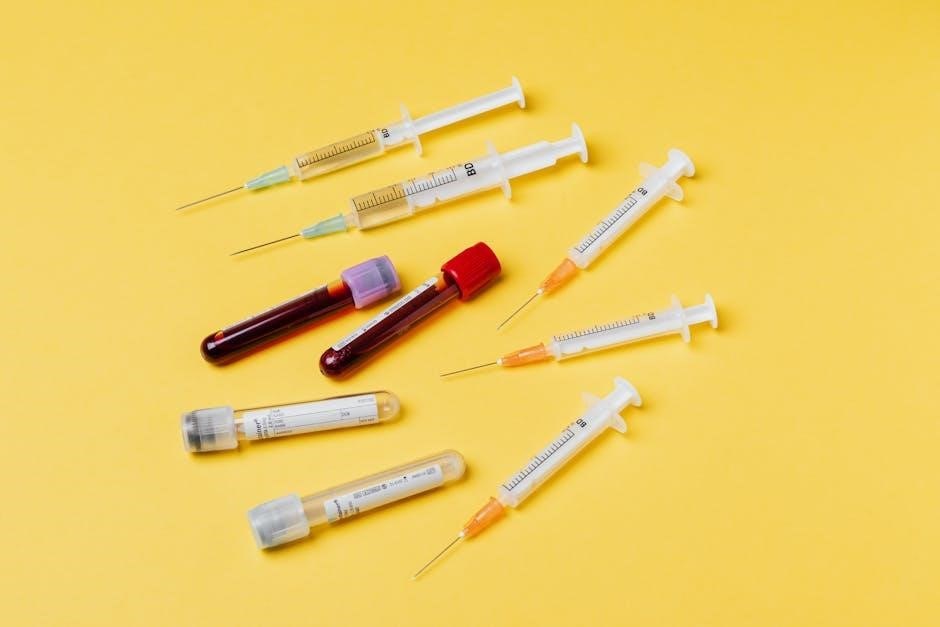Overview of BD Vacutainer Tubes
An overview of BD Vacutainer Tubes is crucial for medical professionals‚ providing a comprehensive understanding of the different types of tubes available‚ including their sizes‚ materials‚ and additives.
The tubes are designed to facilitate the collection of blood samples‚ with various options to suit specific testing requirements.
A thorough understanding of the tubes and their uses enables healthcare professionals to select the most suitable tube for each test‚ ensuring accurate and reliable results;
The tubes are manufactured with a focus on quality and safety‚ adhering to strict standards and guidelines.
Proper use of the tubes requires attention to detail‚ including correct handling and storage techniques.
By familiarizing themselves with the features and benefits of BD Vacutainer Tubes‚ medical professionals can optimize their blood collection procedures‚ ultimately contributing to improved patient care and outcomes.
The tubes are widely used in clinical settings‚ and their popularity can be attributed to their ease of use‚ reliability‚ and versatility.
Overall‚ a comprehensive overview of BD Vacutainer Tubes is essential for medical professionals seeking to enhance their knowledge and skills in blood collection and testing procedures.
Importance of Correct Tube Selection
The importance of correct tube selection cannot be overstated‚ as it has a significant impact on the accuracy and reliability of test results.
Correct tube selection ensures that the blood sample is collected and stored in a way that preserves the integrity of the sample‚ preventing contamination or degradation.
This‚ in turn‚ enables healthcare professionals to make informed decisions about patient care and treatment.
The consequences of incorrect tube selection can be severe‚ leading to inaccurate test results‚ misdiagnosis‚ and potentially harmful treatment decisions.
Therefore‚ it is essential that medical professionals understand the different types of tubes available and their specific uses.
By selecting the correct tube for each test‚ healthcare professionals can minimize the risk of errors and ensure that patients receive the best possible care.
Correct tube selection is a critical step in the blood collection process‚ and its importance should not be underestimated.
Healthcare professionals must be knowledgeable about the different tubes and their uses to provide high-quality patient care.
Proper training and education are essential to ensure that medical professionals can select the correct tube for each test.

BD Vacutainer Tube Types and Uses
Tube Additives and Their Functions
Tubes with additives play a crucial role in blood collection and testing‚ as they help to preserve the sample and ensure accurate results. The additives used in BD Vacutainer tubes include anticoagulants‚ such as citrate‚ EDTA‚ and heparin‚ which prevent blood clotting and preserve the sample for testing. Other additives‚ such as clot activators and gel separators‚ help to accelerate the clotting process and separate the serum from the blood cells. The functions of these additives are critical to the quality of the test results‚ and their selection depends on the type of test being performed. Proper use of tube additives is essential for accurate and reliable test results‚ and medical professionals must be familiar with the different types of additives and their functions to ensure the best possible outcomes for patients. The selection of the correct tube additive is a critical step in the blood collection process‚ and it requires careful consideration of the testing requirements.
Tube Sizes and Draw Volumes

Tube sizes and draw volumes are critical factors in blood collection‚ as they affect the quality and accuracy of test results. BD Vacutainer tubes are available in various sizes‚ ranging from small to large‚ and each size has a specific draw volume. The draw volume is the amount of blood that the tube is designed to hold‚ and it is essential to fill the tube to the recommended level to ensure accurate test results. The tube sizes and draw volumes are carefully calibrated to provide the optimal amount of blood for testing‚ and medical professionals must be familiar with the different tube sizes and their corresponding draw volumes. Proper use of tube sizes and draw volumes helps to prevent errors and ensures that patients receive accurate diagnoses and treatment. The tube sizes and draw volumes are indicated on the tube label‚ and medical professionals must follow the guidelines for filling the tubes to the recommended level.

Guidelines for Using BD Vacutainer Tubes
Mixing Technique and Handling

The proper mixing technique for BD Vacutainer tubes is crucial to ensure accurate test results. According to the guidelines‚ each tube should be gently inverted 180 degrees and back to mix the blood sample with the additives. This technique helps to prevent clotting and ensures that the sample is well mixed. The tubes should not be shaken vigorously as this can cause hemolysis and affect the test results. Proper handling of the tubes is also essential to prevent contamination and exposure to biohazards. The tubes should be handled with care‚ and the caps should be securely tightened after collection to prevent leakage. By following the proper mixing technique and handling procedures‚ medical professionals can ensure that the blood samples are collected and prepared correctly for laboratory testing‚ which is essential for accurate diagnosis and treatment of patients. The guidelines for mixing technique and handling are provided by the manufacturer and should be followed carefully.
Recommended Order of Draw
The recommended order of draw for BD Vacutainer tubes is a crucial step in the blood collection process. The Clinical and Laboratory Standards Institute (CLSI) provides guidelines for the order of draw to ensure that the blood samples are collected correctly. The order of draw is designed to minimize contamination and ensure that the samples are collected in a way that prevents interference with laboratory tests. The typical order of draw is blood culture bottles‚ coagulation tubes‚ serum separator tubes‚ and then other additive tubes. This order is designed to prevent contamination of the blood culture bottles and to ensure that the coagulation tubes are filled before the serum separator tubes. By following the recommended order of draw‚ medical professionals can ensure that the blood samples are collected correctly and that the laboratory tests are accurate. The order of draw is an important step in the blood collection process and should be followed carefully to ensure accurate test results. Proper training is essential to ensure that the order of draw is followed correctly.
